Alexanders and our local rainfall
Yes, Graham, having checked in Ellis and Ellis (which is reckoned to be the authority on tiny fungi) it seems that your sample was indeed Puccinia smyrnii. And E&E confirm that very few fungi live on Alexanders, but this one is very common.
The weather here in Upminster is quite extraordinary. January was fairly normal. But February fill-dyke didn't, March was even drier. We had some very warm weather in March: it felt to us like July for much of it. Then very cold, with hail, for a few days, and it has hardly stopped raining since. Using the data from our wonderful Upminster weather website, our rainfall figs are: Jan, 55mm; Feb, 18.3mm; March, 15.8mm, and now April, 106.4mm.
The first three months add up to 88.1mm, so April has had substantially more rain than all the first 3 months added together! Bluebells are totally confused and many have not flowered after an attempt far too early that was killed off, and all sorts of strange things. This is what the pundits said about global heating: that we would get much more disturbed weather, with things happening at the wrong seasons, and more extreme weather generally.
The media have been saying this is the wettest drought ever! Because, of course, this is the wrong sort of rain! But it is no good moaning, we all have to just do what we can!
But today is forecast to be sunny pretty well all day, so let's make the most of it! April 15th - 21st
A charmless week of northerly wind and rain. Sunday, Tuesday, Wednesday, Thursday and Saturday were all cold and wet to a greater or lesser degree; Monday and Friday wet only in the late afternoon and evening! It's all to do with the jet stream, or so I'm told. Last summer it arched above southern England and the low pressure systems which it helps create dumped all their rain on Scotland; this spring it is arching below us and depositing all the foul weather on the southern counties while the Scots get off lightly. Let's hope it reverts to normal before long as they are more used to it than we are!
Mary has gripped me off, as they say in the ornithological trade, as it is now April 28th and I still have not heard a Cuckoo. It doesn't really surprise me as each spring hope springs eternal but each year most migrants seem to arrive in smaller numbers than the one before. Studies suggest that Cuckoos do not parasitize small birds at random but that each bird specialises in certain species; thus there are Meadow Pipit Cuckoos, Reed Warbler Cuckoos, Dunnock Cuckoos etc etc. Perhaps for this reason they are doing well in parts of Scotland while in a county like Essex you tend to find more in wetland areas, which are largely on the coast, as this is where Reed Warblers and Meadow Pipits are to be found. Inland, they are a scarce bird in many areas. It is probably all down to the way we farm. In the past few decades virtually every last weed has been eradicated from arable fields and many of the insects that fed there - not just the harmful species but the harmless and beneficial ones as well - have been decimated by insecticides. The birds were bound to follow and they have. Don't visit most arable farms unless you are into counting Wood Pigeons! As for this year, my sponsored Cuckoo, Chris, one of five radio tagged by the BTO last spring, is still loafing around in northern Italy, deterred from moving back to Norfolk by the hostile weather. Can't say I blame him!
Still, it's not all doom and gloom, just mostly! Friday morning provided the sunniest and warmest few hours of the week and were spent helping to carry out the first of this year's Breeding Bird Survey transects at Blue House Farm. There were a few Sedge Warblers singing, fresh in from the Sahel, a Cuckoo was heard (but not by me!), there were a dozen Swallows and House Martins hawking for insects over the marsh, and the first Lesser Whitethroat of the spring was rattling away in one of the hedgerows. The last named is likely to have moved through Cyprus on its way north from Africa, an island where it is estimated that up to a million small birds are slaughtered each year for the delicatessen trade. So much for EU regulations protecting them!
There were even a few butterflies enjoying the sunshine, namely, two Green-veined Whites, a Peacock and an early Small Copper. On the same day last year there were 52 Green-veined, 18 Orange Tip, 9 Peacock and 2 Small White but temperatures were 3`C above average then, not 5`C below! We also found a Water Ladybird, a species which feeds on aphids in waterside vegetation.
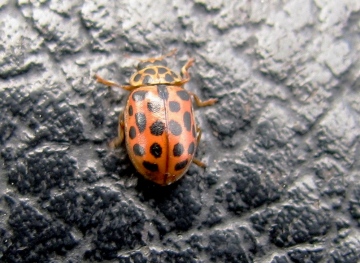 Finally to a subject I know very little about - plant galls. Some years ago I thought that it would be nice to introduce Alexanders from the coast to my garden at Ingatestone. Now I can't get rid of the ruddy stuff! It reproduces from seed in great abundance and seems able to regenerate from even a fragment of taproot left in the soil, a bit like the Dandelion! This year I noticed that several of the leaves on some plants were infested with pustules that I presume are some kind of gall. On consulting Margaret Redfern's and Peter Shirley's 'British Plant Galls' I find that there is but one species listed as being found on Smyrnium, namely, Puccinia smyrnii, which is caused by a rust. The description seems to match the photos I took, to whit, "both surfaces of leaves, and stems, blistered and thickened by spermogonia and yellow aecia, followed by dark brown telia on the undersides of leaves only". In case you were wondering, a sporangium is an organ that produces sporangiospores; an aecia an organ that produces aeciospores, and a telia is (correct) an organ that produces teliospores. Mary, you are into obscure fungi. Any idea if this is a valid ID? Or perhaps you know someone who does know?
Finally to a subject I know very little about - plant galls. Some years ago I thought that it would be nice to introduce Alexanders from the coast to my garden at Ingatestone. Now I can't get rid of the ruddy stuff! It reproduces from seed in great abundance and seems able to regenerate from even a fragment of taproot left in the soil, a bit like the Dandelion! This year I noticed that several of the leaves on some plants were infested with pustules that I presume are some kind of gall. On consulting Margaret Redfern's and Peter Shirley's 'British Plant Galls' I find that there is but one species listed as being found on Smyrnium, namely, Puccinia smyrnii, which is caused by a rust. The description seems to match the photos I took, to whit, "both surfaces of leaves, and stems, blistered and thickened by spermogonia and yellow aecia, followed by dark brown telia on the undersides of leaves only". In case you were wondering, a sporangium is an organ that produces sporangiospores; an aecia an organ that produces aeciospores, and a telia is (correct) an organ that produces teliospores. Mary, you are into obscure fungi. Any idea if this is a valid ID? Or perhaps you know someone who does know?
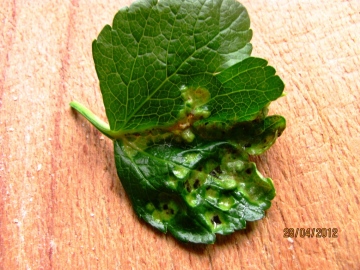 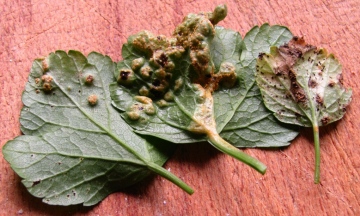
Friday 27 April finds
Out in the wilds of open countryside between Wennington and Rainham I had next to no rain, only a few spits and spots at times, but my husband went up to London and got drenched! We always knew that South Essex gets less rain than anywhere else, and yesterday confirmed that. I was in clouds of St Mark's Flies for much of the day. I don''t much like them as they get in my hair and fly too close for comfort. They are easy to identify as they are quite large flies, all black and rather hairy, and their long black legs hang down while they are flying, but folk who know tell me they are harmless. 25th April is St Mark's Day, so these flies were good at following their own rules. There were huge swarms of them.
In the same area I heard a cuckoo! Only one bird, who called twice within about 5 minutes. No trees close by, so where he was I have little idea, but presumably within about 500m radius of me. I was especially glad to hear this harbinger of spring, as we are being told that they are nearly extinct in UK due to global warming. It seems that British small birds, the ones that usually host cuckoos' eggs, are nesting and with young a little earlier every year, and the cuckoo arrives at his regular time but is too late, as nestlings fill the nests instead of eggs. But at least we should be getting an increase in the small birds that previously had been heavily parasitised by cuckoos. April Micro Moths.
Moth trapping during April has been very unproductive with just small numbers being recorded, However my searches at work in Braintree and of local Woodland for Micro Moths has been much more successful, Eriocrania subpurpurella have been common at work along with Heliozela sericiella, a Pammene argyrana was a nice find resting on Oak and a worn Argyrotaenia ljungiana tested my identification skills.
I have found a couple of notable species during April, during a lovely walk around Danbury Common on the 15th i discovered a number of Incurvaria pectinea flying around low scrub, these Moths are similar to other species so care must be taken with identification.
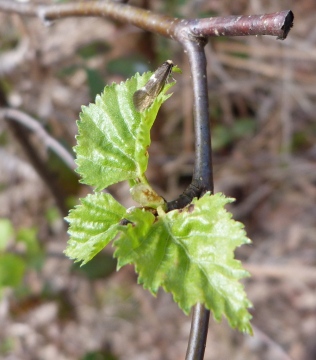
On the 21st whilst looking for Eriocrania sparrmannella in Pods Wood Tiptree, [i found 2] i noticed some leaf mines in Birch, after checking various internet resources i have discovered that thet are Eriocrania sangii, a Scarce Essex species.
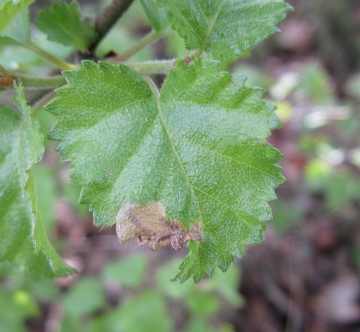 Steve Rolls
Steve Rolls
April 8th-14th 2012
Another week dominated by northerly winds, the days varying between cold and wet and sunny with heavy afternoon showers, the temperature peaking at around 12`C compared with 20`C or more a fortnight ago.
Bluebells are now out in force in the local woods and have been joined by Yellow Archangel and Shirt Buttons; even a few early Plum Puddings. At Thrift Wood, Bicnacre, an area coppiced by the Blue House volunteers two winters ago is now a sea of Wood Anemones while at the farm itself Sea and Sticky Mouse-ears are coming into bloom on the counter walls and the first spear like shoots of Upright Chickweed are forcing their way through the soil while hundreds of diminutive Mouse Tail are crowding the dried mud on the banks of a neighbour's pond. The last two springs have been so dry that most of the chickweed wilted before it could flower and it is to be hoped that this week's rain (and that which is predicted to follow) will revive the fortunes of both this and other annual flowers such as Grass Vetchling, that have also suffered in the drought.
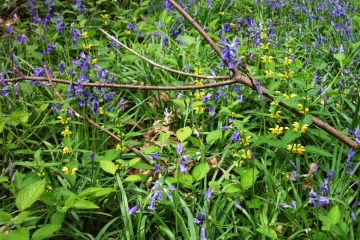
On the Writtle Park estate coppicing is continuing in some of the woods, not only Deerslade (mentioned elsewhere) but also Writtle Park Wood, one of a series of three coppices that were planted in the late 17th, early 18th centuries. Apparently they intend to carry out the work at the rate of around 2-4 hectares a year and as there are around 150 hectares that need coppicing it should last some while! It will only continue, of course, while demand remains high, wood being a commodity like any other, but as there are now around four billion people on this planet all understandably determined to jump aboard the same gravy train we have been riding for the past fifty years, there is a good chance of that happening! In the past the coppicing cycle on the estate was every 12-17 years but it would need to be longer than that for Hornbeam, which largely goes for firewood, but not for Sweet Chestnuts, the poles of which make excellent fence posts. The picture shows the medieval woodbank that separates Deerslade (Highwood, formerly Writtle) and Stoneymore (Ingatestone). It would have been even more impressive in its heyday but a hundred years or more of leaf-fall have filled the ditch beneath the bank.
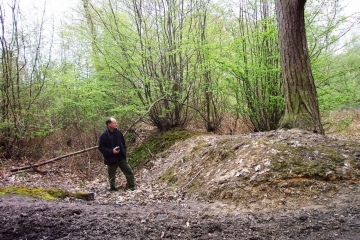
It was a grotty week for insects but I did at last record the sixth and final common bumblebee, namely, the Common Carder Bee Bombus pascuorum in my garden. My first Small White of the year was another visitor, during a break in the cloud on 11th, and Speckled Woods were on the wing during a trip to Capel Manor, Herts on 14th.
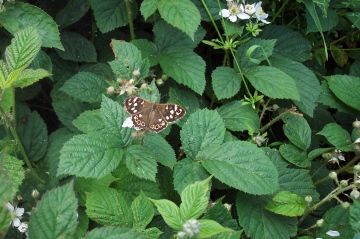
A few more migrants struggled in during the week including Willow Warblers at Bradwell, Nightingale at Two Tree Island and Whimbrel at Blue House but a deep low pressure over southern Europe as well as here is preventing many birds from moving northwards. The BTO's migration blog shows a picture of fifty or so Swallows huddled dejectedly out of the rain beneath the eaves of a bird hide in the Pyrenees while Chris, my sponsored Cuckoo (one of five radio tagged by the BTO last spring), who spent much of the winter in the Congo, is still in northern Italy awaiting a change in the weather so that he can travel the final few hundfred miles back to Norfolk. April 1st to 7th 2012
Sheep. Like hoodies they always seem to get a bad press; the one considered stupid and docile, the other stupid and aggressive. In the former’s case we apply the term ‘dumb animal’ to anything we wish to exploit for our own ends; ‘dumb’ implying there is neither sense nor feeling. In the same way we condemn some animals as ‘vermin’ so that we can subject them to all manner of cruelties with a clear conscience. We live by words. If sheep are so dumb how come they have thrived for millions of years in many shapes and forms, each evolving the attributes that best suited their survival along the way. Why do we view them so disparagingly? Is it because although science teaches us that evolution occurs on a broad front most humans persist in viewing it as a linear process with us firmly at the apex. Evolution created man in its own image perhaps? It has certainly given us dominion over the beasts of the earth. Thus we always compare other creatures intelligence directly with our own, conveniently ignoring the possession of attributes that are far superior to anything we possess. Anyway, if we are so intelligent why do we persist in developing ever more powerful technologies that we are often too dumb to use wisely? My case rests!
There are lots of sheep at Blue House at the moment. And lambs. Lively lambs, full of bounce and inquisitiveness born of innocence. So trusting. Perhaps they are dumb after all! Domesticated sheep need a good deal of TLC at this time of year. This is not because of the way they have evolved but because of the way they have been bred. For instance, ewes have a habit of rolling on to their backs and then find they can’t get upright again. If they remain too long in this position gases build up in their bodies that eventually kill them. A shepherd once told me that modern sheep are prone to this mishap because they have been bred to have broader backs; broader backs making better lamb chops! Mind you, it was April 1st when he told me this so he could have been pulling my leg. It is all too believable though! A more likely reason is that so many ewes carry twin lambs nowadays they become particularly rotund; indeed triplets are not uncommon, which is a bit unfair on both mother and young as she has only two teats. The current high price for lamb in this commodity driven age ensured the weakest gets the extra help it needs though.
Wikkipedia informs me that animal behaviourists have discovered that sheep can recognize individual human as well as fellow flock member’s faces and can remember them for years. They can also differentiate emotional states through facial characteristics while within flocks they tend to congregate in family related groups. With patience a sheep will also learn to recognize its name but it is to be sincerely hoped that those at Blue House do not recognize some of the names the reserve stockman calls them! There is even anecdotal evidence from Yorkshire of sheep problem solving by learning to negotiate a cattle grid by rolling over on their backs. Aggression is not something that one normally associates with sheep but apparently there are bully boys in flocks, just as there are in human society, and these often attain dominance. Icelandic sheep are renowned for their high levels of aggression, especially ewes with young lambs, a fact to which I can bear testimony through personal experience during a cycling holiday some years ago. I was standing astride my bike, looking at something in the sky (a Gyr Falcon as it turned out) when I was suddenly catapulted backwards down a steep gravelly slope. An outraged ewe followed me down and began head butting my shins so I scrambled hastily to my feet and skedaddled out of the immediate area. The ignominy of the situation remains with me still. Mind you, having read the Icelandic sagas the behaviour of their sheep should have come as no surprise to me; indeed, the saga of Shaun Bloody Horn is probably tucked away among them somewhere.
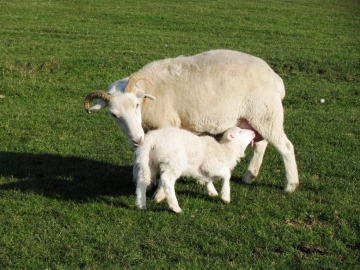
The picture shows a Wiltshire Longhorn and lamb. This rare breed variety has a self-shedding fleece and later in the spring they have a distinctly woebegone look to them, the fleece hanging off in large tufts, a sight which often alarms visitors but is perfectly normal. A wild sheep that couldn't shed its fleece in summer would be in big trouble.
Enough about sheep! Spring is back on hold. The high pressure system that gave us two weeks of warm sunny weather has now shifted into the Atlantic and we find ourselves on the 'wrong' side of it, northerly winds having replaced the previously mild south-westerlies. Chilly days and cold nights! On past experience we could be trapped for two or three weeks of such weather.
A few exceptionally early spring migrants have been reported this week including a Cuckoo at Writtle on 2nd, Reed Warbler at Bradwell on 3rd, a Hobby and Tree Pipit at Blue House Farm on 5th and a Common Redstart, also at Bradwell, on 7th but passage generally has been at a low ebb despite the recent fine weather. A bonus for me was a superb Red Kite at Writtle Park on 2nd, one of the last breeding sites in Essex (they were shot by gamekeepers in 1845!) and hopefully soon to follow its fellow raptor, the Buzzard, back to this area.
Insects do not seem to think much of the northerly winds, particularly butterflies, but I did see my first Green-veined White of the year at Margaretting Tye on 6th. There was also a belated report of over 100 Black Oil Beetles counted along a one kilometre stretch of seawall between Coate and Bridgewick Outfalls on the Dengie coast during March's hot weather, a truly astonishing number of this scarce species.

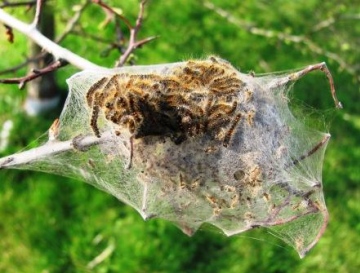
The dormant webs of Brown-tailed Moths are also coming back to life as the caterpillars emerge from their winter hibernation and begin feeding again. The hairs can cause painful skin rashes or breathing problems in some people but Cuckoos gorge on them with no ill-effects. That was in the past, though; there are now far fewer Cuckoos and far more Brown-tails and - once really common only along the coast - they have now spread to most inalnd parts of Essex. March 25th to 31st 2012
Seem to be struggling to keep up to date with these weekly entries, probably because I am currently bogged down trying to organise the BTO's Nightingale Survey in Essex. Attempting to find 200 volunteers to cover a similar number of tetrads is proving to be a struggle but, fortunately, virtually everyone knows what this iconic bird sounds like and as many, if not more, conservation volunteers, entomologists, botanists and mycologists (most of them Field Club members) have come forward to help out as have birders, probably because they are more used to doing survey work as a matter of routine.
Weather wise, it was another week of glorious sunshine and warm temperatures, reaching 23`C at Tollesbury Wick EWT Reserve on 29th. Like Steve, there have been exceptional numbers of Common and Small Quakers in my garden moth trap at Ingatestone this spring and both Twin-spotted Quaker and Oak Beauty have proved to be commoner than in any previous year since 1990. This may be because I have upped the power of my UV light from 40W to 60W this spring or it may be, as Steve suggests, due to the unusually warm weather. Never have discovered why the Victorians called them Quakers : because they are subdued in dress and restrained in manner perhaps?!
The first three Swallows of the spring had arrived at Blue House Farm on 30th. A lone Swallow may not a summer make but three, that's distinctly more promising, and its always pleasing to greet the first ones home before the close of March. Spring flowers are also coming to the fore. Primroses and Celandine everywhere; swathes of Coltsfoot at Writtle Park, Wood Anemones coming into bloom at The Backwarden and both Moschatel (pictured), otherwise known as Town Hall Clock, and even the first tentative blooms of Bluebell in The Grove at Ingatestone.
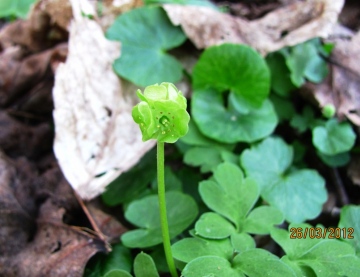
My garden is also beginning to hum with insects, a long overdue Garden Bumblebee Bombus hortorum among them. Five down, one common species to go! Among hoverflies, Eristalis pertinax, Meliscaeva auricollis and Eupeodes latifasciatus were three common ones confirmed on capture. Other bees are also getting numerous but I hesitate to guess at what species for fear of Peter coming down on my head like a ton of bricks! One I did recognise though was the Tawny Mining Bee while up to 50 queen Common Wasps have been feasting on the resin like sap exuded by the new shoots on the Nordmannii Spruce. This Sexton Beetle Nicrophorus humator turned up in the moth trap, recognizable by the orange tufts on the tip of its antennae. It is one of the burying beetles, the crypts of churches being one of its favourite habitats, hence the name
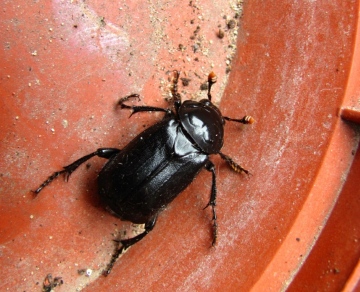
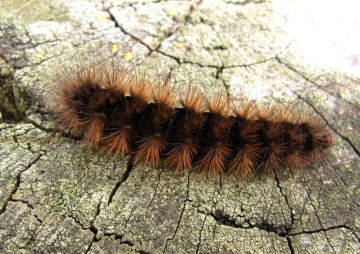
Another find this week was this Woolly Bear at Blue House, the caterpillar of the Cream-spot Tiger Moth; the maroon coloured head being the best ID feature. The caterpillars of its cousin, the Garden Tiger, were abundant locally when I was a boy, especially at this time of year when they are marching to and fro looking for somewhere to pupate, and we used to catch and rear them at home. There are still a few corners of Essex where the adult moth is of regular occurrence but I have caught precisely one here in the past 22 years. The Cream-spot, though, is still a frequent sight on the coastal marshes. 7-Spots, Pines,and Kidney Spot Ladybirds
A drought seems set to plague farmers/gardeners, but one plague they surely wont see this year is aphids, not here in N.E.Essex anyway. Having survived the cold, thousands of 7-Spots are on the move. On 23.2.12 I counted 90 in our small garden in north Colchester and there have been between 30-50 on various other dates. Huge numbers have also been noted at Highwoods, Mistley, Dedham, and Stourwood. At Skinners Wall, Manningtree 100+ were seen in a nettle bed just a few square feet in size.
Another possible benefit for gardeners could be an attack on scale insects. Pine Ladybirds are also more numerous too, with a maximum count of 49 on one beech tree at Mistley Walls with smaller numbrs in our garden, Highwoods, Dedham, and Stourwood where a Kidney Spot was also noted. |
|
Archives:
May 2020
Aug 2019
Jan 2019
Sep 2018
Jul 2016
Oct 2015
Jul 2015
May 2015
Apr 2015
Mar 2015
Feb 2015
Jan 2015
Dec 2014
Oct 2014
Sep 2014
Aug 2014
Jul 2014
May 2014
Apr 2014
Mar 2014
Feb 2014
Jan 2014
Dec 2013
Nov 2013
Sep 2013
Aug 2013
Jul 2013
Jun 2013
May 2013
Apr 2013
Mar 2013
Feb 2013
Jan 2013
Dec 2012
Nov 2012
Oct 2012
Sep 2012
Aug 2012
Jul 2012
Jun 2012
May 2012
Apr 2012
Mar 2012
Feb 2012
Jan 2012
Dec 2011
Nov 2011
Oct 2011
Sep 2011
Aug 2011
Jul 2011
Jun 2011
May 2011
Apr 2011
Mar 2011
Feb 2011
Jan 2011
Dec 2010
Nov 2010
Oct 2010
Sep 2010
Aug 2010
Jul 2010
Jun 2010
May 2010
Apr 2010
Mar 2010
Feb 2010
Nov 2009
Oct 2009
Aug 2009
Jul 2009
Jun 2009
May 2009
Apr 2009
Mar 2009
Feb 2009
Jan 2009
Nov 2008
Oct 2008
Sep 2008
Aug 2008
Jul 2008
Jun 2008
May 2008
Apr 2008
Mar 2008
Feb 2008
Jan 2008
Dec 2007
Nov 2007
current posts
|


































